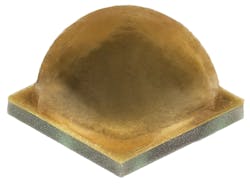Cree ramps efficacy 10% in the 5-mm XHP50 packaged LED family
From a roughly 6-mm light emitting surface, Cree's newest LEDs deliver more than 2500 lm and come in 6V and 12 V configurations.
Cree has announced a second generation of LEDs in its Extreme High Power (XHP) product portfolio with improvements both in lumen output and efficacy. The XHP50.2 LEDs (also a new product labeling scheme for Cree) measure 5×5 mm and include four emitters in a discrete style LED package. The new LEDs feature a 7% boost in lumen output relative to the original XHP50 products and a 10% efficacy improvement that solid-state lighting (SSL) product developers can leverage in multiple ways.
Interested in articles & announcements on packaged LED technology?
Cree targets the XHP50 packaged LED line at demanding applications including street lights and high-intensity spot lights where lumen output is critical. The initial products in the family were launched almost two years back when Cree revealed the SC5 (Silicon Carbide 5) LED manufacturing platform. At the original launch, Cree said the SC5-based LEDs delivered double the light output of competitive LEDS in the same form factor.
The latest XHP packaged LED from Cree can deliver up to 2654 lm to enable high-intensity spot and street lighting.
The LEDs are available in 6V and 12V nominal forward-voltage configurations and can be driven at a maximum of 3A and 1.5A, respectively. At maximum current lumen output is 2654. Cree said typical forward voltages are actually 11.2V and 5.6V and that leads to maximum efficacy of 165 lm/W whereas the first-generation products were in the 125–132-lm/W range.
As is typically the case with evolutionary LED announcements with newer products offering upgraded performance, SSL developers can easily update existing product designs passing on the performance improvement either in terms of maximum lamp or luminaire output or in improved energy efficiency at the same output level of prior products. Or developers can shrink product form factor using fewer LEDs. And being that the second-generation packaged LED products are based on the same basic technology platform as the first XHP50 products, Cree was able to quickly deliver the LM-80 data that is necessary for certifications such as Energy Star.
Already lighting manufacturers are making plans to use the new LEDs. "Our goals are to achieve the best cost-efficacy and versatility using the most efficient LEDs," said Lorenzo Trevisanello, R&D manager of Arianna. "Thanks to the XHP50.2 LED’s lumen density and proven reliability, even at high operating temperatures and drive currents, we are able to push the performance and size boundaries of our products even further. Arianna shares Cree’s vision that LEDs should not compromise quality or performance and should provide better lighting experiences in all aspects."
Cree now has XHP LEDs across three form factors. At the original launch, the company announced 7×7-mm XHP70 LEDs. And then in mid-2015, Cree announced the 3.45×3.45-mm XHP35 LEDs. Those LEDs are in the same footprint as other popular Cree high-power LEDs including the XP-G/G2, XP-L, and XP-E/E2.

Maury Wright | Editor in Chief
Maury Wright is an electronics engineer turned technology journalist, who has focused specifically on the LED & Lighting industry for the past decade. Wright first wrote for LEDs Magazine as a contractor in 2010, and took over as Editor-in-Chief in 2012. He has broad experience in technology areas ranging from microprocessors to digital media to wireless networks that he gained over 30 years in the trade press. Wright has experience running global editorial operations, such as during his tenure as worldwide editorial director of EDN Magazine, and has been instrumental in launching publication websites going back to the earliest days of the Internet. Wright has won numerous industry awards, including multiple ASBPE national awards for B2B journalism excellence, and has received finalist recognition for LEDs Magazine in the FOLIO Eddie Awards. He received a BS in electrical engineering from Auburn University.





